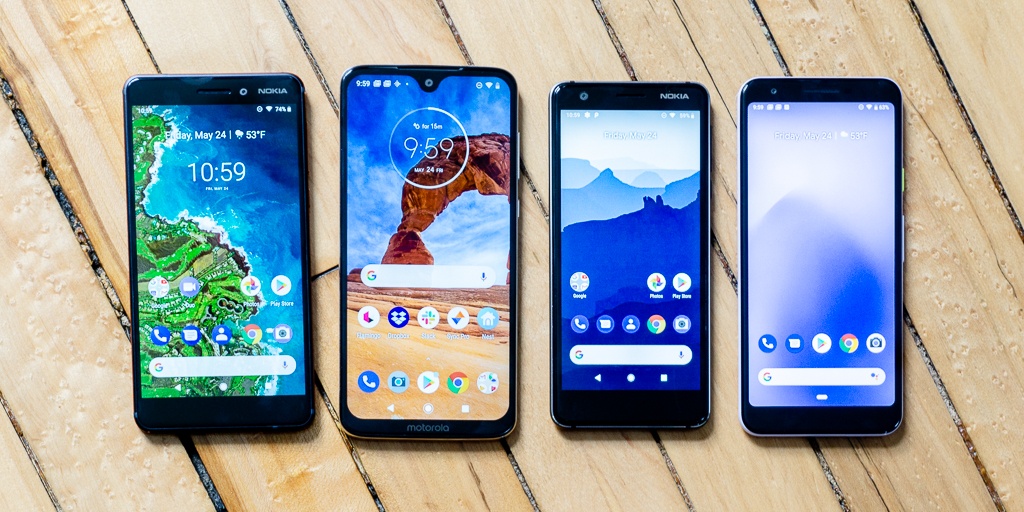If you are a person with a disability or a personal care attendant, direct support worker, or other caregiver, you may have heard about the looming menace of electronic visit verification. Due to lobbying from medical technology companies, notably Sandata Technologies, the 21st Century Cures Act of 2016 added a requirement that Medicaid funded personal care attendant programs implement electronic visit verification. Electronic visit verification (EVV) uses a smartphone app to verify a caregiver’s identity and the date, time, and location where personal care services were provided. The purpose is supposedly to prevent fraud, although fraud in home care services is extremely rare.
EVV GPS Tracks & Restricts Innocent U.S. Citizens
Although the Center for Medicare and Medicaid Services has stated that GPS tracking is not required for electronic visit verification, many states have wrongly interpreted the law and have chosen to use GPS to track people with disabilities and their caregivers. This means if you have a disability and need personal care attendant services, you will be forced to disclose your exact location to the government every time your attendant clocks in and out.
To make matters even worse, most electronic visit verification apps also use geo-fencing. The EVV app is set with GPS coordinates where it believes the person with a disability “should” be located (their home) when aides are clocking in or out. If the phone is not at that location, the app registers an “exception” and flags the visit for further scrutiny. There are already reports of caregivers not getting paid because GPS does not work well at their client’s home and the app recorded them as being several miles away. What happens when people with disabilities and our personal care attendants travel to another city, state, or even country?
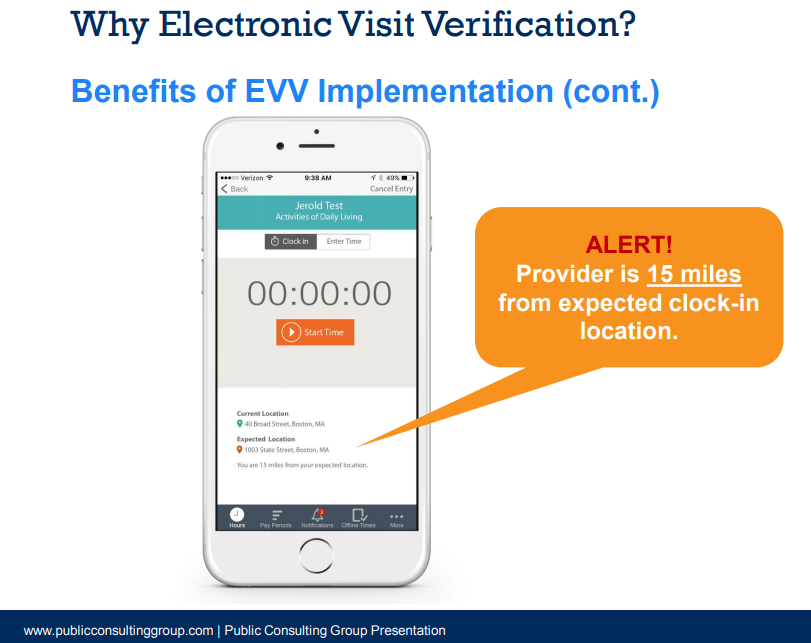
This slide from an EVV Time4Care app presentation touts privacy invasion via GPS tracking as a positive feature.
EVV Is Unconstitutional
GPS tracking with electronic visit verification is an assault on the rights and freedoms of people with disabilities and our caregivers. The EVV systems being rolled out in most states were designed with no apparent awareness that people with disabilities travel, have jobs, and spend time with our families. They violate our civil rights by turning our homes into de facto institutions. People with disabilities have a constitutional right to live in our own homes and communities and make decisions about our lives, established in the Supreme Court ruling Olmstead v. LC. EVV infringes on the rights guaranteed by Olmstead by limiting our freedom of movement.
All Americans have the right to be free from unreasonable search and seizure under the Fourth Amendment of the U.S. Constitution. In 2012, the Supreme Court ruled in United States v. Jones that GPS tracking a person constitutes a search under the Fourth Amendment of the U.S. Constitution. In the 2018 case Carpenter v. United States, the Supreme Court ruled that the government must obtain a warrant to access phone geolocation data. In other words, the government has no right to track a citizen’s location without probable cause that a crime has been committed. EVV is blatantly unconstitutional.
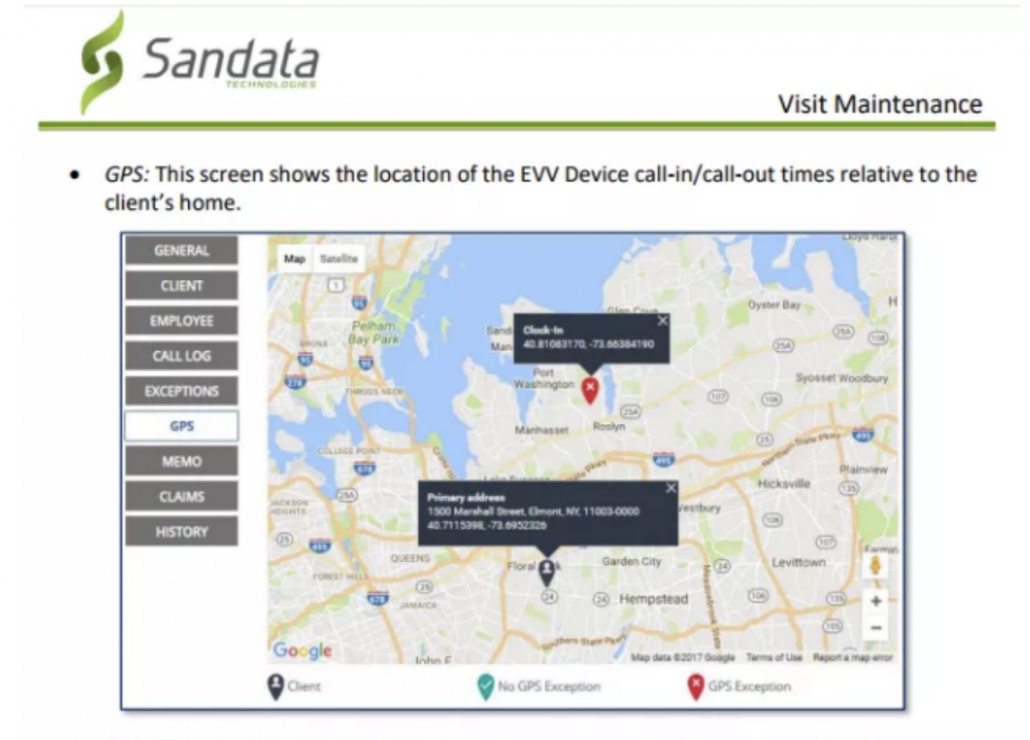
Screenshot of Sandata EVV app’s unconstitutional warrantless surveillance of people with disabilities.
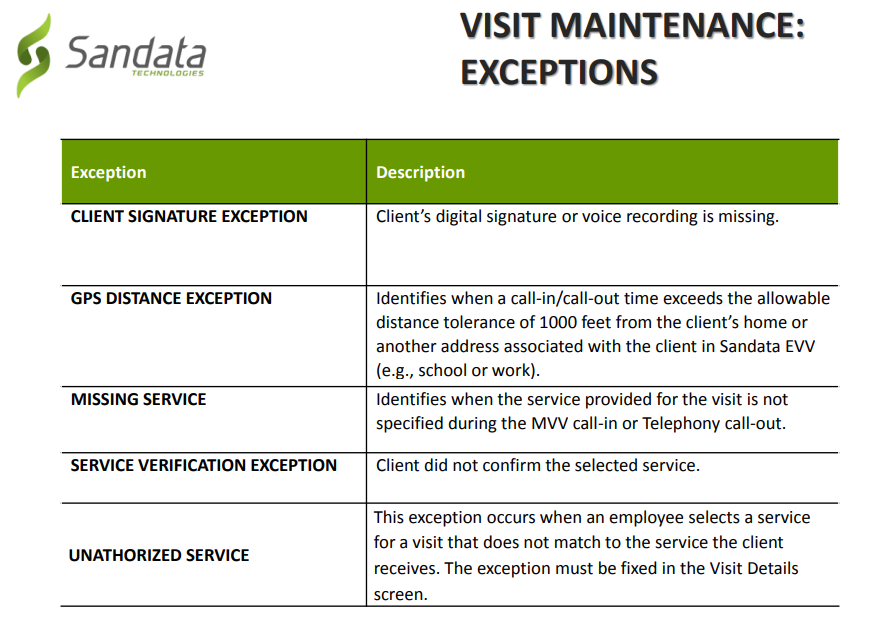
Sandata EVV software treats a person with a disability leaving their home as an “exception” requiring a special approval process.
EVV treats us like criminals on an ankle monitor rather than honest citizens with the right to go anywhere we please. It makes us prisoners in our own homes. It is a massive threat to my right to pursue my career as a travel blogger. Geo-fencing would prevent me from attending my employer’s company meetings as well as disability rights conferences and other important events.
I have never been so incensed at an attack on my rights as I am about electronic visit verification. That’s why I am so deeply committed to fighting EVV and helping to protect others from having their rights and freedoms stolen. I plan to refuse to be GPS tracked at all and I encourage others to do the same.
We cannot stop this law unless we are willing to fight it. But unfortunately, refusing EVV may put people with disabilities at risk of losing the personal care attendant services we require to live. Therefore, some people may be too afraid to refuse EVV entirely, and may instead continue to use an EVV app while fighting to repeal the law.
I don’t want to see anyone trapped in their home or prevented from traveling because of EVV. That’s why I decided to find a way to fight electronic visit verification using technology.

How to Hide Your Location From EVV Apps
By using the methods outlined on this page, you can effectively bypass electronic visit verification and prevent the government from knowing whether you leave your home and where you go, as is your Constitutional right. You can hide your location from the EVV GPS tracker and appear to be at home even if you are thousands of miles away living your life with the support of your personal care attendant.
Hiding your location is not a substitute for advocating to repeal electronic visit verification. It is a temporary measure to reduce the likelihood you will be harmed by the unconstitutional restrictions of EVV while it remains in effect.
Disclaimer: Use this information at your own risk. This guide is only to be used to protect your location data and not to subvert any legitimate aspects of EVV such as recording the number of hours a caregiver works.
Required Equipment
To hide your location from intrusive electronic visit verification apps, you will need an Android smartphone. Up until now, I’ve always been a dedicated iPhone user, but researching these issues has shown me how much Apple limits users from controlling our own devices. None of the methods I’ve found will work on an iOS device unless you jailbreak it.
Due to the extreme privacy invading nature of EVV, I recommend getting a separate Android smartphone just for running the EVV app and not putting any sensitive information on it. Buying a separate EVV phone also allows your caregivers to retain their privacy when not at work. Many caregivers are quitting rather than installing EVV software on their phones, and honestly, I don’t blame them. Even if you choose not to bypass EVV GPS tracking using the methods I discuss, you’ll be more likely to retain your personal care attendants if they can use your mobile device to clock in and out at work instead of being forced to install a malicious, intrusive app on their own phones.
I know buying another smartphone may present a cost barrier to many people with disabilities who are low income, but I recommend looking for refurbished Android phones on eBay, your local Craigslist and Facebook Marketplace. For this tutorial I purchased a used Samsung Galaxy S7 in perfect condition for under $100 on eBay. If you don’t already have one, you may also be able to qualify for a Lifeline phone.
Option 1: Spoof your GPS location
The simplest way to protect your privacy with EVV is to use a GPS spoofing app to set your phone’s location at your home. Once set, the app will send the fake location data to all other apps that collect GPS locations, including the EVV app.
To spoof your GPS location, you will need an Android smartphone. Unfortunately, Apple makes GPS spoofing on iPhones very difficult. You would need to either jailbreak your phone or go through a complicated process using software called iTools and connecting your iPhone to a computer.
If you’re using this method with a separate EVV-only phone as I recommend, you’ll need Internet access on that phone. If you don’t want to/can’t afford another line and you’re clocking in and out from someplace other than your home Wi-Fi (that is the point of all this, after all!), you can connect to public Wi-Fi or use your real phone as a hotspot.

Here I used the free GPS spoofing app GPS Emulator to set my location as the Sandata Technologies office in Port Washington, NY.
Since the state where I live has not imposed GPS tracking yet, I cannot assess how well specific spoofing apps work with EVV apps. If you try it, please email me with your experiences, good or bad, and I’ll update this article. Your name and any identifying information will be kept private!
Option 2: Control a phone with the EVV app remotely.
By using a free program called TeamViewer, you can connect to an Android mobile device from anywhere and do anything, including run apps. Although this method is slightly more complicated to set up initially, it is more reliable and safer than GPS spoofing. Based on my research, apps can’t detect that you are using it, and the EVV app will always register you as being at home because the device will be at home. Here’s how to set it up:
Step 1: Have two phones ready.
You will need two electronic devices, as follows:
Device 1: EVV phone. This MUST be an Android smartphone or tablet — an iPhone or iPad will not work. You do not need phone service on this device, just Wi-Fi access. This device will stay in your home at all times, and I recommend leaving it plugged into a charger.
Device 2: Personal phone. This is the device you carry with you. It can be your existing iOS or Android smartphone. You can also use a Mac or PC computer, but I recommend using a smartphone for portability reasons.
Step 2: Setup
1. Begin by downloading the TeamViewer app onto your personal phone. Set up an account.
2. Use your EVV phone to download the app TeamViewer Host from the Google Play store. You will see multiple TeamViewer apps, but this is the only one that will allow you to control the phone remotely without someone on the other end. Install the app and any add-on app that is required for it to work.
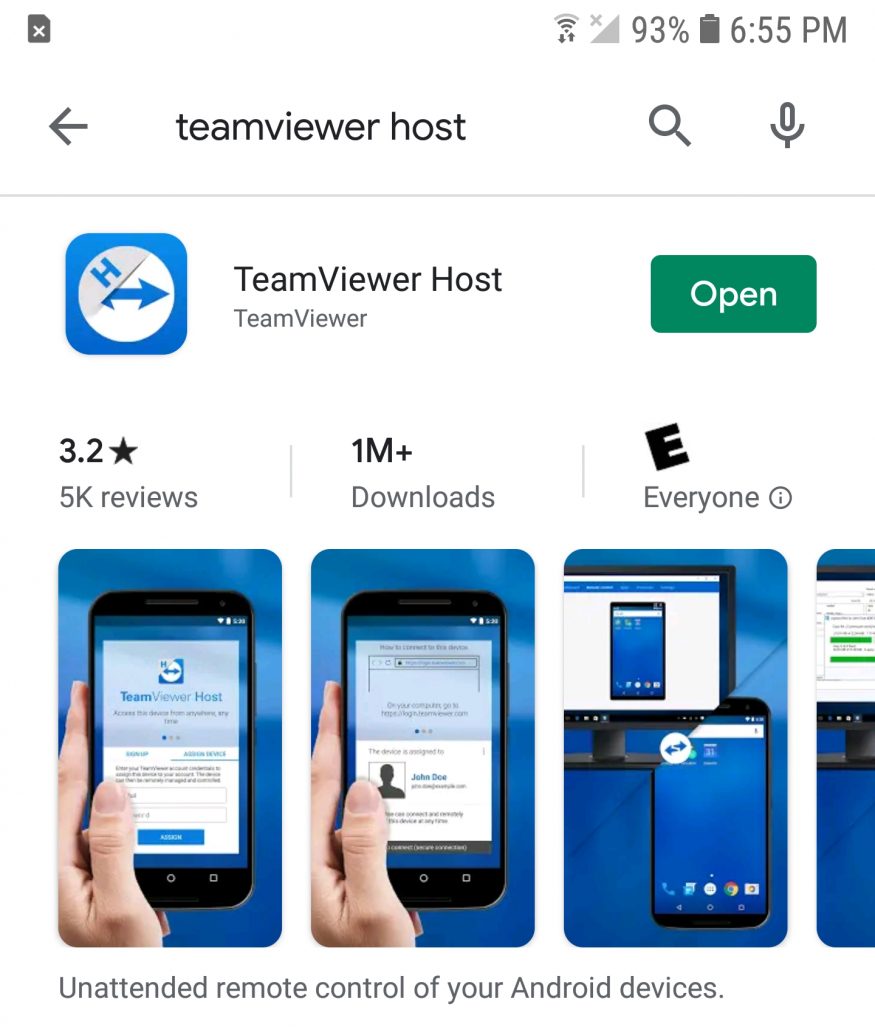

3. Add the EVV phone to your existing TeamViewer account. This will allow you to control the EVV phone from your personal phone.
4. Install the EVV software you are expected to use on the EVV phone. Give it any permissions it requests and make sure it is working.
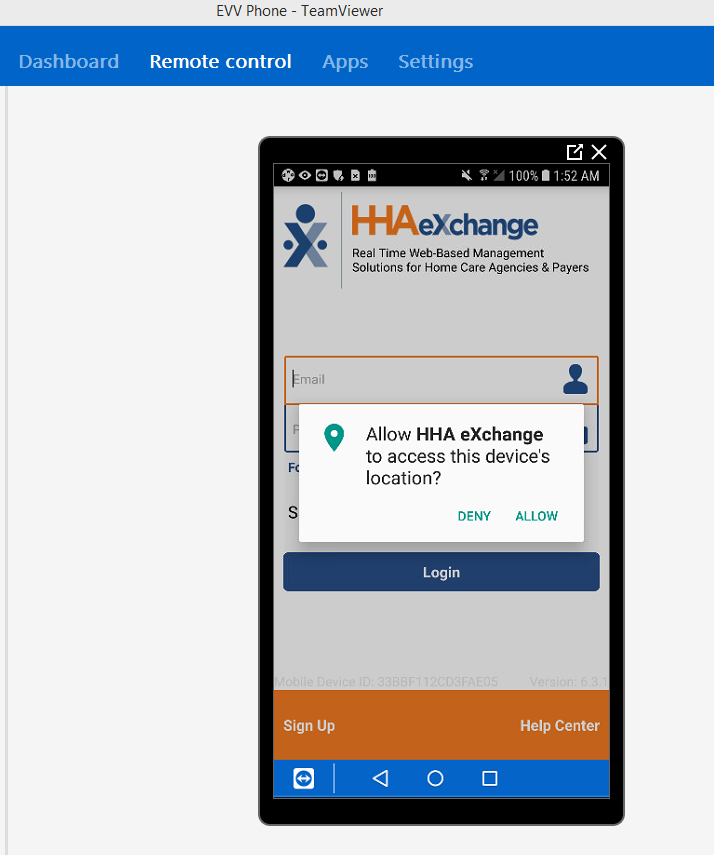
Using the TeamViewer PC program to access the EVV phone.
Step 3: Test and Use
1. Using the TeamViewer app on your personal phone, connect to the EVV phone. You will see the EVV phone screen on your screen.
2. Open the EVV app and clock in or out as needed. The EVV app will check the GPS of the device it is installed on, not the device you’re using to connect to it. Therefore, you can connect to the device from anywhere but still be recorded as being at home.
Step 4: Add additional users
If needed, you can install TeamViewer on additional devices and give those devices access to the EVV phone. For example, if you don’t want your PCA using your personal phone to clock in and out when you’re traveling together, you could set it up on your tablet for them to use.
Keep in mind, anyone you have given TeamViewer access can control anything and everything on the EVV phone. Therefore, I advise against using that phone for anything other than EVV.
More Ways to Fight EVV
Although these methods can help individuals protect their privacy from EVV, they may not be feasible for everyone. We must fight to repeal electronic visit verification on the national level and in particular ban the use of GPS and biometrics to track people with disabilities and our caregivers. Please visit the following websites / groups to join our fight for freedom.
Stop EVV
Citizens Against Electronic Visit Verification — Facebook group

60,291 , 3


